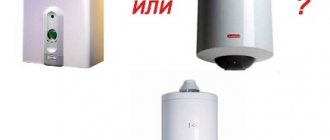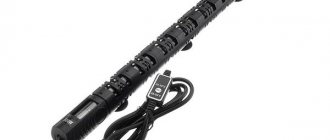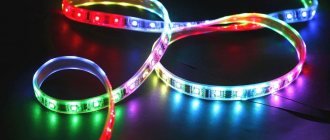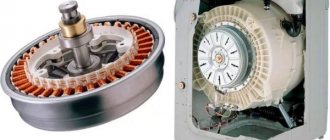How to choose the right speaker system for your home
Before purchasing an acoustic set, you should decide for what purpose the purchase is being made, in which room the equipment will be placed and the desired sound quality. After which the desired price category is set, since the cost of audio equipment fluctuates greatly. When choosing equipment, pay attention to the following selection criteria.
Type of acoustic design. One of the key characteristics that, in fact, distinguishes one speaker system from another. Let's add: if you are a professional. An ordinary person is unlikely to distinguish the sound of a bandpass type from a closed type. But if you attended a music school as a child or just want to get the best, then know that there are five types of acoustic design:
- Bass reflex. The most common type of home acoustics; the vast majority of devices on the market belong to this category. As professionals say, it has good bass, but the sound detail is not great.
- Passive emitter. About the same as the bass reflex type, but the bass is a little better.
- Open speakers (subtype - horn type). If they are strategically placed around the room, you can create that notorious acoustic zone with one hundred percent immersion. However, the bass from open speakers is poor.
- Bandpass housing (aka bandpass). For loudness lovers, speaker systems of this type sound the most powerful.
- Closed type. The most accurate in terms of sound transmission, but the least powerful. And again the problem is with the bass.
Number of stripes. To greatly simplify it, the more bands, the deeper and more voluminous the sound. And more expensive, of course. For home acoustics, the number of bands can be from 1 to 3.5.
Power. For home use, an AC power of 25-40 W is sufficient; for a large room, you can purchase a more powerful system, up to 150 W,
Frequency range. If equipment is purchased primarily for watching movies or computer games, then you should pay attention to speakers that can transmit low frequencies - from 10 Hz. For music lovers, it is preferable to purchase speakers with a frequency capability of up to 40 thousand Hz.
Material for equipment. Wood conveys sound best.
The highest quality speakers are made from MDF, less preferably from chipboard; the aluminum body ensures good safety of the equipment, but the sound in it is distorted. Plastic is not durable.
How to choose for your home
When choosing speakers for your home, you need to pay attention to technical characteristics, such as frequency range, number of bands, playback area, impedance level, maximum sensitivity and compactness. Here are some useful tips to help you choose acoustics for your home:
- The frequency range does not matter. Often, budget models have a wider frequency range than professional speakers. The fact is that it is quite difficult to measure exact spectrum indicators, so manufacturers sometimes indicate range limits at random. It is better to focus on the amplitude-frequency characteristic, which more accurately indicates the expressiveness of different tones.
- The more stripes, the better. Bands are emitters that reproduce different parts of the frequency range. The more speakers the speakers have, the better the sound will be. Two-way and three-way audio systems are perfect for home use, but for professional use it is better to take more functional models.
- The larger the room, the more powerful and louder the system should be. For small rooms up to 18 square meters, active built-in, suspended or shelf acoustics are suitable. For large rooms, it is better to choose a floor-standing one with several modules.
- Sensitivity controls volume. The higher the sensitivity, the louder the device will sound. The main thing is to make sure that the sound does not distort at high volume levels.
- The power of the speakers should be equal to the power of the amplifier. Do not underestimate or overestimate the potential of the device - just compare the power ratings of the speakers with the power of the receiver.
Also pay attention to the dimensions of the device. You should not choose bulky speakers for small apartments, as they will take up a lot of space and will not provide the desired sound. Powerful acoustics in small rooms can hum or distort the sound.
The best acoustic systems price-quality
DALI SPEKTOR 2
The ceiling system from DALI is in no way inferior to its floor counterpart. This is the optimal solution for small rooms, for which strong power only harms, and floor-standing speakers cannot be installed so easily. The sound will be very good. Another advantage of this system is that for a pleasant sound you don’t need to mess with the settings, or even use the equalizer. They immediately sound right. Technical characteristics:
2-way AC bass reflex type
frequency range 54-26000 Hz
sensitivity 84.5 dB
ordinary
dimensions 170x292x238 mm
Advantages
- Power is perfect for a small room
Flaws
- sometimes you can get “Chinese” build quality
Dali SPEKTOR VOKAL
Compact active speakers are suitable for home or hardware use. The body of the product consists of wood and will decorate any room. The model belongs to the middle price category and pleases users not only with high-quality sound, but also with simple controls. The system can be installed in any room. Specially used technologies make it possible to obtain diffuse sound functions.
Advantages
- universal use
- stylish design
- comfortable feet for installation
Flaws
- not found
YAMAHA NS-SW050
Floor standing subwoofer for home. Complements speaker systems, complements sounds in films and music. Equipped with mono/LFE line input (RCA). Power: from 50 W to 100 W. Frequency range: 25-180 Hz. There is a removable grille, however, to remove it, you will have to make every effort. In their reviews, owners note the compact size, practical form factor, and excellent sound quality. Among budget subs, he is one of the best.
Advantages
- The device’s power is enough for a room of 20-25 m²
- price
- quality of workmanship
- bass is soft and deep
Flaws
- For greater sound purity, it is better not to set the settings to maximum power
- no cutoff frequency control
- Power cord won't come off
- no sleep mode
- no ON/OFF button
Magnat Tempus Center 22
Center 22 belongs to the new Tempus series from a reliable German manufacturer.
The case is reliably assembled, characterized by durability and protection against corrosion. Specifications:
| Location | Shelf |
| Acoustic type | Passive |
| Purpose | Home |
| Peak power | 150 W |
| Frequency range | 34-45000 Hz |
| Sensitivity | 91 dB |
| Impedance | 8 ohm |
| Weight | 6 kg |
Advantages
- availability
- loud speakers
- clear sound
- suitable for home and garden
- increased frequency range
- compact dimensions
Flaws
- not found
YAMAHA NS-F140
The acoustic circuit is two-way. Low and mid frequencies are taken over by a 16-centimeter speaker, while the “top” frequencies are taken over by a 3-centimeter dome tweeter. The sensitivity is not the highest - 86 dB, which must be taken into account when choosing an amplifier. The polar pattern is narrow, so you will have to tinker with the choice of speaker orientation, but you will definitely be pleased with the low distortion (they cross the 1% threshold only at frequencies below 60 Hz, which is expected with such a woofer design), and the frequency response is from 100 Hz to 10 kHz by the standards of budget acoustics, it’s very decent: if you distribute the sound by frequency on an amplifier or receiver, adding a good subwoofer to these speakers and not forcing them to pass through the very bottom part of the spectrum, then the result will definitely please you. Especially for this money.
Advantages
- Design
- Price
Flaws
- Sensitivity to spatial orientation
- The “highs” are rather weak – but in comparison with acoustics of a higher class
Recommendations for choosing budget acoustics.
All Hi-Fi systems up to approximately 60 thousand rubles. will differ little in sound quality from the conventional Microlab. Since all cheap Hi-Fi is produced from components of approximately similar quality, on similar or the same lines, in the same China.
We are talking about an acoustics-amplifier set. And not in the way Hi-Fi audio equipment sellers usually do - by “attaching” an amplifier worth 100 thousand rubles to speakers worth 40 thousand rubles at a demonstration. Yes, the sound then seems to be normal. But this is already a system for 140 thousand rubles.
Acoustics of this class have one thing in common: savings on materials reach the point of indecentness.
If only you knew what kind of trash budget acoustics are made from. And you can understand them - reducing the cost by only $1 in a batch of 10 thousand. PC. $10,000 is automatically earned. And costs are reduced by far from $1. But no one can see what’s inside. And this process is so exciting and exciting that it is done an infinite number of times. Sometimes to the point where the wires become so thin that they begin to perform an additional function for them - fuses. I saw this personally.
You can indirectly understand the quality of the materials used by the weight of the acoustics. For example, if a car usually weighs a little over a ton, it can under no circumstances be good at 300kg.
Cars weighing 300kg are not made for safety reasons. In acoustics, there is no safety problem, and they save on the rigidity of the housing, the amount of metal, and the magnetic system. It cannot be said that with a normal weight the acoustics will be of high quality. But you can know with absolute certainty that if this weight is underestimated, the quality will definitely not be there.
The housing will rattle and ring. Saving on hardware and the magnetic system leads to “vatness”, as if you put an engine in a car with 2-3 times less power. Of course, it will drive... and it is quite possible to accelerate it to 100 km/h, but there will be very serious problems with its dynamics.
Basically, acoustic quality problems lie in the quantity and quality of materials used.
What a surprisingly fresh idea!!! Just in the style of an old Jewish joke:
The old Jew became famous for his ability to brew very tasty tea. And so, before his death, he gathered his relatives. Then one of them said: “You always prepared such incomparable tea.” Tell us this secret at least now. The old man motioned to everyone who stood by his bed to bend towards him. And when they approached, he whispered: “Jews, do not spare the tea leaves!”
Savings allow us to take filters, for example, to an uncompromising level. Inaccessible to developers from the last century. And the resulting miniature size allows filters to be mounted directly on the terminals.
It is quite simple to understand how much weight an acoustic system should have. Look ahead to the weight of acoustics of this standard size in the middle and expensive price group, where saving on MDF and hardware is already meaningless.
So that you don’t waste time on this, I present average numbers. These figures are fully confirmed by multiple practical experiences. And the weight really turns out this way if you don’t save materials:
- Bookshelf speakers, 5″ speaker, dimensions 180-330-290, estimated weight 1 pc. 8-9 kg.
- Bookshelf speakers, 6.5″ speaker, dimensions 210-380-310, Estimated weight 1 pc. 9-11 kg.
- Two-way floorstanding speakers, two 6.5″ speakers, dimensions 900-200-300, estimated weight 1 pc. 23kg.
- Three-way floorstanding speakers, two 6.5″ speakers, dimensions 900-200-300, estimated weight 1 pc. 25kg.
The meaning of the given values is so that you can cut out the obvious rubbish that passes for Hi-Fi.
For example, if you are offered floor-standing two-way speakers, with two 6.5″ midrange/woofer speakers, typical dimensions of about 900-200-300mm and a weight of 15 kg per speaker…. You don’t even have to consider this option - they will obviously be flimsy. It doesn’t even make sense to find out what exactly will be wrong with them. They won't be able to sound normal.
It should be taken into account that the figures given are correct for acoustics with multiple stiffeners. If there are no stiffening ribs, then the acoustics must weigh even more to ensure the necessary rigidity. But as a rule, if the acoustics have the above weight, they have stiffening ribs. Since there are multiple stiffeners, this is the most economical way to stiffen any structure. And if the speaker does not have stiffeners, this means only one thing - initially there was no goal to make the enclosures of high quality.
There are exceptions associated with various exotics. For example, speaker cabinets are made not from MDF, but from something else, usually for marketing reasons. For example, aluminum or plywood. But about 99% of acoustic enclosures are made from MDF, since in terms of the sum of their characteristics there is nothing even close to MDF. For example, chipboard is much better and lighter, but the error in cutting chipboard is 1 mm. which is absolutely unacceptable, etc.
Also, magnets in speakers can be made of neodymium, which greatly reduces their weight. But in practice, it makes sense to use neodymium only when reducing size and weight is critical. For example, in wind generators. On traditional ferrite magnets, they will simply fall under their own weight. The huge production of wind turbines has caused neodymium prices to soar tenfold in just a few years. The use of neodymium in the magnetic system of the speakers only greatly increases the price without providing any advantages. The purpose of using neodymium is in car tweeters - there will be nowhere to place large tweeters in a car. Or on smartphones.
If we are talking about home acoustics, classic strontium ferrite completely suits everyone and is the basic standard. And the fact that it makes the speakers heavier is wonderful.
The use of high-quality materials allows us to achieve a much more stable result than with the traditional Hi-Fi and Hi-END approach, based on friendship with electrons that hardworkingly warm up the wires. Because today the electrons are friends with you and your head, but tomorrow they may not be.
The first and most important thing you must do when choosing speaker systems is to understand the quality of the components. If everything is in order with the quality issue of the speakers, you will definitely find photos on the Internet of how and what these speakers are made of. The way it is, there is no point in doing well and then hiding this information from buyers.
But of course, it is necessary to understand what kind of acoustics you need and what you want from it even before the stage of choosing a specific pair of speakers.
A typical mistake that confuses people when choosing speaker systems is that they have not yet understood what they need. But at the same time, they get confused about choosing a specific model. Comparing the incomparable with each other.
Buyers already have an idea of what power, size, and form factor the acoustics should be. But as a rule, they do not understand that the “character” of the sound of speakers is determined not by quality and brand, but by only about 10-15 basic types of mixing the speakers together. Basically, the “character” of the sound is determined by its own set of phase distortions.
So, for example, if the acoustics are broadband (one speaker), it will always sound like broadband. Better, worse, more low end... less low end, etc. But the sound “character” will always be the same – like a broadband speaker.
Two-way speakers have more options. The frequency at which the bands are separated is important. If it is at 2-3 kHz it will be one “character”. If at 5-6 kHz it is completely different. And the rigidity with which these strips are cut is a very strong factor influencing the “character” of the sound of the acoustics.
First understand which “character” of sound out of the existing ones you like best. Don't find yourself in a situation where you have to choose between a two-way or a three-way speaker. These acoustics are fundamentally different in sound. First, understand what type of acoustics you need for mixing. After that, see what models of this type exist on the market. And compare them with each other.
Continuation - “Character” of sound. Selecting the type of mixing of household speakers.
[Sassy_Social_Share]
If you find an error, please select a piece of text and press Ctrl+Enter.
The best floor-standing acoustics for the home
Sony SA-CS9
The model is designed to be a quality addition to a home theater or gamer's corner. This is a silent subwoofer that produces vibrations in the range of 28-200 Hz. Together with a subwoofer, it provides surround sound special effects. Thanks to its size of 34.5x29.5x40 cm, you can install the Sony SA-CS9 anywhere, but preferably on a hard and slightly flexible surface.
Advantages
- Takes up very little space
- Attaches firmly to the floor
- Doesn't annoy neighbors with loud noise
Flaws
- Heavy, weight about 11.5 kg
- It is necessary to select a suitable location for installation
YAMAHA NS-F150
Best price. Good voice transmission. Country: Japan (manufactured in Indonesia) Budget HI-FI model of passive type. It features a stylish design and reliable assembly. Connects to a receiver or amplifier and works great in conjunction with subwoofers and other audio equipment. This floor-standing acoustics covers the entire frequency range. There is bass, but not as pronounced as on the sub. Still, the NS-F150 is no longer intended for listening to music, but for watching TV, movies, and games. The middle is not hollow, the tops do not squeak. True, distortion is clearly felt at high volumes. In reviews, owners say that it requires careful setup and a good amplifier/receiver. Out of the box it is unlikely to provide good sound quality.
Advantages
- stylish design
- reliable assembly
Flaws
- rear bass reflex (it is better to place it away from the wall)
- weak tweeters
- complete thin wires
SVEN SPS-750
Double-cavity speakers have a convenient shape and can be installed on the floor or shelf. Externally they have an attractive appearance and will decorate any room. Reproduces sounds of both high and low frequencies with high quality. Wireless connection allows you to place the speakers even outdoors. The system can be controlled using a small remote control.
Advantages
- high-quality sound reproduction
- remote control
Flaws
- Fingerprints remain on the glossy surface
The best powerful budget speakers (loud)
Pioneer S-DJ50X
Monitor speaker measuring 197x301x262 mm, capable of playing music at volumes up to 107 dB. Suitable for parties with electronic music. Low-frequency speakers with modest sizes reproduce dense and clear sound.
Advantages
- Provides automatic shutdown after 25 minutes
- Great bass
- Good design
- There are white and black color options
Flaws
- They may make noise when plugged into an outlet.
Heco Victa Prime Center 102
Heco Victa Prime Center 102 is a center channel speaker system. It is best suited for watching videos. The human voice and vocals sound natural in the audio system, which is valuable for use in a home theater. It is worth noting the quality of the external finish: the matte surface, made to look like dark wood, highlights the polished metal of the speaker rim.
Advantages
- Clearly reproduces the human voice
- Looks like a premium product
- Compact monoblock
Flaws
- For comfortable listening to music, it is better to complement with other speakers
JBL Control 62P
JBL Control 62P is an exception to the rule that powerful inexpensive speakers only come in large sizes. The small and durable speaker has a power of 50 W and a sensitivity of 103 dB. It can be used as a portable one, as it comes with convenient mounts and durable cables for connection. There is no need to throw away your hard-earned money trying to achieve the ideal sound of your audio system. As you can see, for every task there is a solution with high-quality sound and ease of use at a low price.
Advantages
- Very loud for a size just over 12x12x12 cm
- Good sound even in rooms with high ceilings
- Shockproof housing
- Hanging systems included
Flaws
- Single lane
Expert advice
In order for the acoustics to fully fulfill all its characteristics, it is necessary to carefully approach the choice.
- Type. Acoustics are divided into passive, active and hybrid. The first does not require a line signal and power supply to all speakers, but requires an external amplifier. The second is portable, compact, and easy to set up. Hybrid systems include passive speakers and an active subwoofer.
- Number of stripes. The optimal option is two: one is responsible for the lows (and the bottom of the midrange), and the second is responsible for the highs (and the top of the midrange). Of course, a 3-way speaker system provides better sound quality, since different drivers are responsible for the lows, mids and highs. But the average user is unlikely to be able to notice serious differences, but he will have to overpay for such speakers.
- Power. The sound quality depends on this parameter. Based on the area of the premises, a speaker with a power of up to 70 W is sufficient for rooms up to 20 m2. If you need to cover 30 “squares”, then 100 W will be the best option. Rooms over 30 square meters will require 150 W or more.
- Sensitivity. Determines the sound volume taking into account the specified power. As a rule, indicated in dB/W/m: the sound pressure of a radiator with a power of 1 W at a distance of a meter. Sensitivity up to 88 dB is considered low; with a value from 89 to 92 – average; in the range of 94-102 dB – high.
- Frequencies. Conventionally, frequencies perceived by the human ear can be divided into three categories: high, medium and low. If acoustics are purchased for cinema, then they must cover the range from 100 Hz to 20 kHz. For universal models it should be wider (about 20-35000 Hz).
- Interfaces. RCA is necessary for single-channel audio transmission, but the connector's noise immunity is low. XLR, on the contrary, is highly immune to interference. It is considered a professional interface. The acoustics can also be equipped with TRS (3.5 and 6.35 mm), Speakon (needed in concert equipment), etc.
What is a speaker system?
Typically, a speaker system consists of one or more speakers that reproduce sound received from an external source. It works “paired” with audio-video equipment: players, televisions, computers, etc.
Speaker systems differ in format. The most popular options:
- 2.0 is just 2 speakers without a subwoofer;
- 2.1 – 2 speakers, complemented by a subwoofer, which is responsible for low frequencies;
- 3.1 – a set specially designed for home cinema: subwoofer + 3 satellites (1 central and 2 front);
- 5.1 – sub + 5 speakers.
There are also 7.1 acoustics to create a full-fledged home cinema. It includes as many as 7 speakers and a subwoofer.
This is interesting: TOP 10 best 2.1 speaker systems: studying the most popular speakers with a subwoofer
In order for speakers to produce high-quality sound, they need a power amplifier. It can be built-in or connected separately. Depending on this, acoustics are divided into:
- Active (with amplifier). The main advantage of such equipment is that active speakers are more versatile and compact, they fit freely in a small space.
- Passive (without built-in amplifier). The advantage of such equipment is the ability to independently select a suitable amplifier, focusing on personal preferences.
But when buying acoustics, it is not enough to pay attention only to the amplifier and the number of speakers. It is necessary, first of all, to decide in combination with what equipment and under what conditions the equipment will be used. More about this below.











